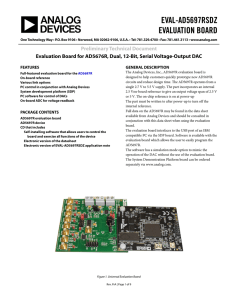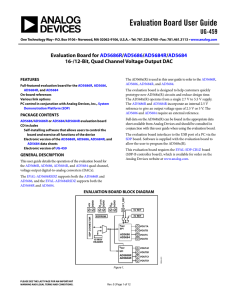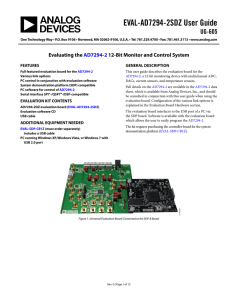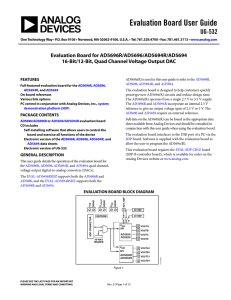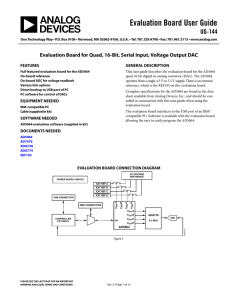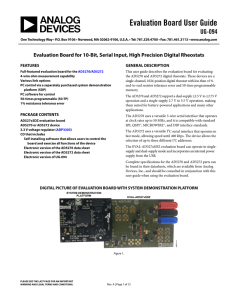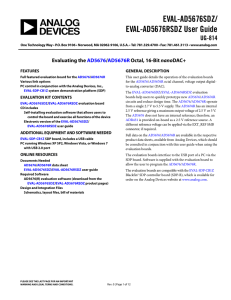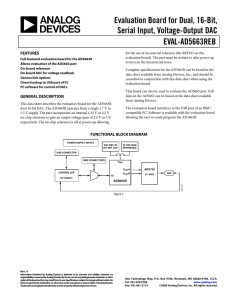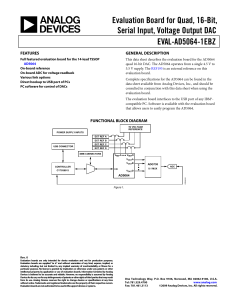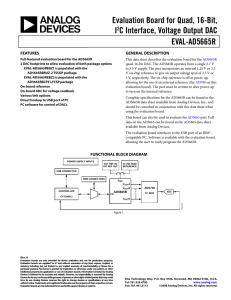Evaluation Board User Guide UG-155
advertisement
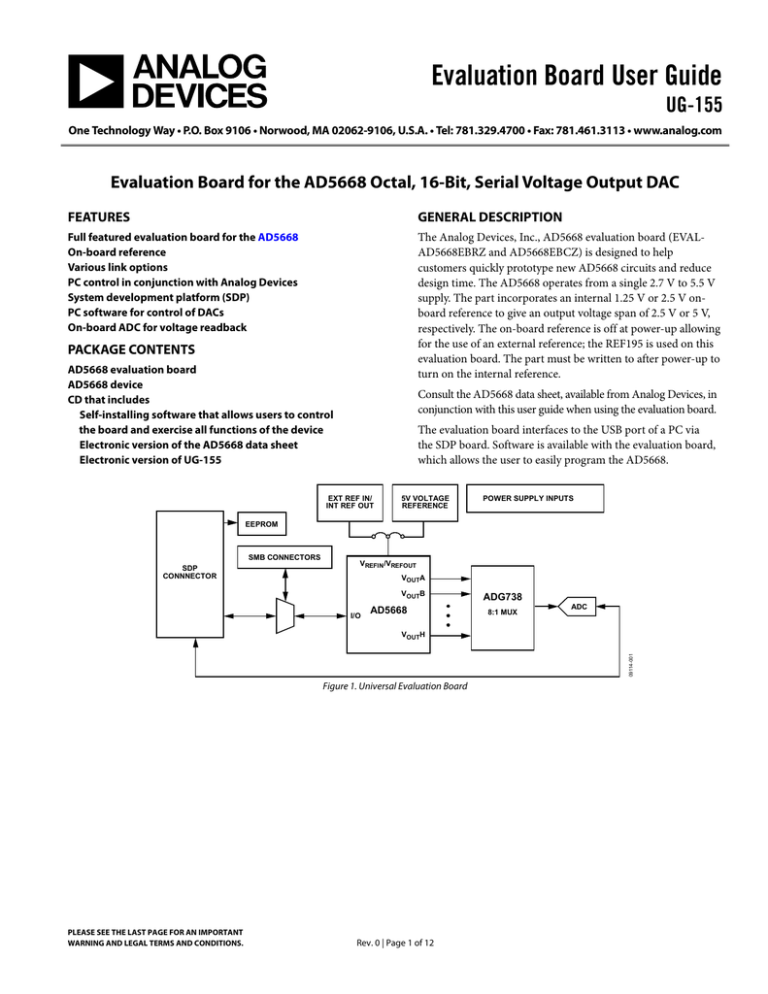
Evaluation Board User Guide UG-155 One Technology Way • P.O. Box 9106 • Norwood, MA 02062-9106, U.S.A. • Tel: 781.329.4700 • Fax: 781.461.3113 • www.analog.com Evaluation Board for the AD5668 Octal, 16-Bit, Serial Voltage Output DAC FEATURES GENERAL DESCRIPTION Full featured evaluation board for the AD5668 On-board reference Various link options PC control in conjunction with Analog Devices System development platform (SDP) PC software for control of DACs On-board ADC for voltage readback The Analog Devices, Inc., AD5668 evaluation board (EVALAD5668EBRZ and AD5668EBCZ) is designed to help customers quickly prototype new AD5668 circuits and reduce design time. The AD5668 operates from a single 2.7 V to 5.5 V supply. The part incorporates an internal 1.25 V or 2.5 V onboard reference to give an output voltage span of 2.5 V or 5 V, respectively. The on-board reference is off at power-up allowing for the use of an external reference; the REF195 is used on this evaluation board. The part must be written to after power-up to turn on the internal reference. PACKAGE CONTENTS AD5668 evaluation board AD5668 device CD that includes Self-installing software that allows users to control the board and exercise all functions of the device Electronic version of the AD5668 data sheet Electronic version of UG-155 Consult the AD5668 data sheet, available from Analog Devices, in conjunction with this user guide when using the evaluation board. The evaluation board interfaces to the USB port of a PC via the SDP board. Software is available with the evaluation board, which allows the user to easily program the AD5668. EXT REF IN/ INT REF OUT 5V VOLTAGE REFERENCE POWER SUPPLY INPUTS EEPROM SMB CONNECTORS SDP CONNNECTOR VREFIN/VREFOUT VOUTA VOUTB I/O AD5668 ADG738 8:1 MUX ADC 09114-001 VOUTH Figure 1. Universal Evaluation Board PLEASE SEE THE LAST PAGE FOR AN IMPORTANT WARNING AND LEGAL TERMS AND CONDITIONS. Rev. 0 | Page 1 of 12 UG-155 Evaluation Board User Guide TABLE OF CONTENTS Features .............................................................................................. 1 Evaluation Board Software ...............................................................4 Package Contents .............................................................................. 1 Installing the Software ..................................................................4 General Description ......................................................................... 1 Running the Software ...................................................................4 Revision History ............................................................................... 2 Software Operation .......................................................................5 Evaluation Board Hardware ............................................................ 3 Evaluation Board Schematics and Artwork ...................................6 Power Supplies .............................................................................. 3 Bill of Materials ............................................................................... 10 Link Options ................................................................................. 3 REVISION HISTORY 6/10—Revision 0: Initial Version Rev. 0 | Page 2 of 12 Evaluation Board User Guide UG-155 EVALUATION BOARD HARDWARE POWER SUPPLIES LINK OPTIONS To power the AD5668 evaluation board, supply 5.5 V between the AVDD and AGND inputs for the analog supply, and supply 5 V between DVDD and DGND inputs for the digital supply. A number of link and switch options are incorporated in the evaluation board and should be set for the required operating setup before using the board. Table 2 describes the positions of the different links to control the evaluation board by the PC, via the USB port, using the AD5668 in single-supply mode. The functions of these link options are described in detail in Table 3. Both AGND and DGND inputs are provided on the board. The AGND and DGND planes are connected at one location close to the AD5668. It is recommended not to connect AGND and DGND elsewhere in the system to avoid ground loop problems. All supplies are decoupled to ground with 10 μF tantalum and 0.1 μF ceramic capacitors. Table 1. Power Supply Connectors Connector No. J1 J2 Voltage Analog positive supply and ground, AVDD and AGND. For single-supply operation, supply 5.5 V. Digital positive power supply, DVDD. For single-supply operation, supply 5 V. Table 2. Link Options Setup for SDP Control (Default) Link No. LK1 LK2 to LK3 LK4 LK5 LK6 LK7 LK8 LK9 to LK14 Options A Inserted Inserted B A A A Inserted Table 3. Link Functions Link No. LK1 LK2 LK3 LK4 LK5 LK6 LK7 LK8 LK9 to LK14 Option This link selects the AVDD power supply source for the analog circuitry:` Position A selects J1 as the AVDD analog circuitry power supply source. Position B selects the DVDD source as the AVDD analog circuitry power supply source (see LK6). This link connects the VOUTG pin of the AD5668 to the input pin of the ADG738 demultiplexer, so that DAC output value can be monitored using the on-board AD7476 ADC. This link connects the VOUTH pin of the AD5668 to the input pin of the ADG738 demultiplexer, so that DAC output value can be monitored using the on-board AD7476 ADC. This link connects a 0.1 μF capacitor to AGND on the VREFIN/VREFOUT pin. It is recommended to connect this when using the internal reference. This link selects the reference source: Position A selects the internal reference as the reference source. The part must be written to via software to turn on the internal reference. Position B selects the on-board 5 V reference as the reference source. This link selects the 5 V power supply source for the digital circuitry: Position A selects V_IO as the 5 V digital circuitry power supply source. Position B selects J2 as the 5 V digital circuitry power supply source. This link selects the DAC voltage source: Position A selects the AVDD analog circuitry power supply source. Position B selects the on-board 5 V reference as the power supply source. This link sets the RESET pin on the ADG738: Position A allows normal operation of the switch. Position B resets the switch. This link connects the VOUTA to VOUTF pins of the AD5668 to the input pins of ADG738 demultiplexer, so that the DAC output value can be monitored using the on-board AD7476 ADC. Rev. 0 | Page 3 of 12 UG-155 Evaluation Board User Guide EVALUATION BOARD SOFTWARE INSTALLING THE SOFTWARE The EVAL-AD5668EBZ evaluation kit includes self-installing software on CD. The software is compatible with Windows® XP, Windows Vista (32 bits), and Windows 7 (32 bits). To obtain drivers for 64-bit operating systems, contact Linear.Apps@analog.com. 1. 2. 3. 4. Start the Windows operating system and insert the CD. The installation software must open automatically. If it does not, run the setup.exe file from the CD. After installation is completed, power-up the evaluation board as described in the Power Supplies section Plug the EVAL-AD5668EBZ into the SDP board, and plug the SDP board into the PC using the USB cable included in the box. When the software detects the evaluation board, proceed through any dialog boxes that appear to finalize the installation. 09114-002 Install the software before connecting the SDP board to the USB port of the PC. This ensures that the SDP board is recognized when it connects to the PC. Follow these steps: Figure 2. Pop-Up Window Error 3. Determine if the SDP board is connected to the boards. If the SDP board is not connected to the evaluation boards, a message box appears as shown in Figure 3. Check the connection between the SDP and EVAL-AD5668EBZ boards and run the program again. RUNNING THE SOFTWARE 2. Click Start > All Programs > Analog Devices > AD5668> AD5668 Evaluation Software. To uninstall the program, click Start > Control Panel > Add or Remove Programs > AD5668 Evaluation Software. Determine if the SDP board is connected to the USB port. If the SDP board is not connected to the USB port when the software is launched, a connectivity error is displayed (see Figure 2). Simply connect the evaluation board to the USB port of the PC, wait a few seconds, click Rescan, and follow the instructions. Figure 3. Error Message If the SDP board is connected, the System Development Platform connects briefly. 09114-004 1. 09114-003 To run the program, do the following: Figure 4. System Development Platform Wait Window 4. Rev. 0 | Page 4 of 12 Notice that the main window of the AD5668 evaluation software then displays, as shown in Figure 5. UG-155 09114-005 Evaluation Board User Guide Figure 5. AD5668 Evaluation Board Main Window SOFTWARE OPERATION 3. In the Data Bits section, enter the data in decimal format in the Enter Value field. To execute, click Write to Part. Note that you must click Write to Part to execute all writes to the part. 4. The voltage output on each DAC channel is monitored using the on-board ADC. To read the output voltage, click SAMPLE, in the ADC section (in the upper right of the window). 5. To set up the power-down DAC bits, the clear code register bits, and the LDAC register bits, select the appropriate option from the drop-down menu under Command Menu and click Write to Part. You can also set the register bits for the required mode of operation. Consult the AD5668 data sheet for details. 6. To set LDAC and CLR to high or low, click the corresponding check box under Hardware Pins. Because this command is executed immediately, there is no need to click Write to Part. Follow the steps below to operate the software: 1. From the Analog Devices menu, click Start > All Programs > Analog Devices >AD5668 > AD5668 SDP Evaluation Software. For older PCs, click Start > Programs > Analog Devices > AD5668 >AD5668 SDP Evaluation Software. The AD5668 main window opens, as shown in Figure 5. The data programmed into the 32-bit input shift register is displayed. You can select the command bits, the address bits, and the data bits by clicking the appropriate button under each area. 2. To select a command to program the part, select the appropriate option from the drop-down menu under Command Menu. For example, to program all DAC outputs with full scale , select Write to and Update DAC channel n and then click All DACs under Address Bits. Rev. 0 | Page 5 of 12 UG-155 Evaluation Board User Guide EVALUATION BOARD SCHEMATICS AND ARTWORK 09114-006 Figure 6. Schematic of AD5668 Evaluation Circuitry Rev. 0 | Page 6 of 12 Evaluation Board User Guide UG-155 09114-007 Figure 7. Schematic of SDP Connector Rev. 0 | Page 7 of 12 Evaluation Board User Guide 09114-008 UG-155 09114-009 Figure 8. Component Placement Drawing Figure 9. Component Side PCB Drawing Rev. 0 | Page 8 of 12 UG-155 09114-010 Evaluation Board User Guide Figure 10. Solder Side PCB Drawing Rev. 0 | Page 9 of 12 UG-155 Evaluation Board User Guide BILL OF MATERIALS Table 4. Qty. 1 1 1 9 3 6 1 1 2 3 1 2 13 9 4 1 2 1 1 1 Reference Designator U8 U7 L1 LK2, LK3, LK4, LK9, LK10, LK11, LK12, LK13, LK14 LK5, LK7, LK8 J4, J5, J6, J7, J8, J9 J3 U3 J1, J2 C2, C3, C9 C7 LK1, LK6 TP1 to TP12 C1, C4, C5, C6, C8, C10, C19, C20, C21 R1, R2, R3, R4 R5 U4, U5 U1 U2 U6 Description 12-bit ADC Matrix switch/multiplexer Ferrite bead Jumper block, 2-way, 2.54 mm pitch spacing Supplier/Part Number Analog Devices AD7476 Analog Devices ADG738 Digi-Key 490-1024-1-ND FEC 1022247 and 150-411 Jumper block, 3-way, 2.54 mm pitch spacing SMB jack 50 Ω 120-way female connector 32 kb I2C serial EEPROM Terminal block, 2-way Case A 10 μF capacitor 0603 10 μF capacitor SIL header, 3-way Red test point 0603 100 nF capacitor FEC 1022248 FEC1206013 FEC 1324660 FEC 1331330 FEC 151789 FEC 197-130 FEC 318-8840 FEC 512-047 and 150-411 FEC 8731144 (pack) FEC 8820023 SMD resistor 0603 1.5 Ω resistor, 5%, 0.063 W Octal buffer/line driver Octal 16-bit DAC with on-chip reference in LFCSP Octal 16-bit DAC with on-chip reference in TSSOP Low dropout voltage reference FEC 933-0399 FEC 9331832 FEC 9591915 Analog Devices AD5668(CP) Analog Devices AD5668(RU) Analog Devices REF195 Rev. 0 | Page 10 of 12 Evaluation Board User Guide UG-155 NOTES Rev. 0 | Page 11 of 12 UG-155 Evaluation Board User Guide NOTES ESD Caution ESD (electrostatic discharge) sensitive device. Charged devices and circuit boards can discharge without detection. Although this product features patented or proprietary protection circuitry, damage may occur on devices subjected to high energy ESD. Therefore, proper ESD precautions should be taken to avoid performance degradation or loss of functionality. Legal Terms and Conditions By using the evaluation board discussed herein (together with any tools, components documentation or support materials, the “Evaluation Board”), you are agreeing to be bound by the terms and conditions set forth below (“Agreement”) unless you have purchased the Evaluation Board, in which case the Analog Devices Standard Terms and Conditions of Sale shall govern. Do not use the Evaluation Board until you have read and agreed to the Agreement. Your use of the Evaluation Board shall signify your acceptance of the Agreement. This Agreement is made by and between you (“Customer”) and Analog Devices, Inc. (“ADI”), with its principal place of business at One Technology Way, Norwood, MA 02062, USA. Subject to the terms and conditions of the Agreement, ADI hereby grants to Customer a free, limited, personal, temporary, non-exclusive, non-sublicensable, non-transferable license to use the Evaluation Board FOR EVALUATION PURPOSES ONLY. Customer understands and agrees that the Evaluation Board is provided for the sole and exclusive purpose referenced above, and agrees not to use the Evaluation Board for any other purpose. Furthermore, the license granted is expressly made subject to the following additional limitations: Customer shall not (i) rent, lease, display, sell, transfer, assign, sublicense, or distribute the Evaluation Board; and (ii) permit any Third Party to access the Evaluation Board. As used herein, the term “Third Party” includes any entity other than ADI, Customer, their employees, affiliates and in-house consultants. The Evaluation Board is NOT sold to Customer; all rights not expressly granted herein, including ownership of the Evaluation Board, are reserved by ADI. CONFIDENTIALITY. This Agreement and the Evaluation Board shall all be considered the confidential and proprietary information of ADI. Customer may not disclose or transfer any portion of the Evaluation Board to any other party for any reason. Upon discontinuation of use of the Evaluation Board or termination of this Agreement, Customer agrees to promptly return the Evaluation Board to ADI. ADDITIONAL RESTRICTIONS. Customer may not disassemble, decompile or reverse engineer chips on the Evaluation Board. Customer shall inform ADI of any occurred damages or any modifications or alterations it makes to the Evaluation Board, including but not limited to soldering or any other activity that affects the material content of the Evaluation Board. Modifications to the Evaluation Board must comply with applicable law, including but not limited to the RoHS Directive. TERMINATION. ADI may terminate this Agreement at any time upon giving written notice to Customer. Customer agrees to return to ADI the Evaluation Board at that time. LIMITATION OF LIABILITY. THE EVALUATION BOARD PROVIDED HEREUNDER IS PROVIDED “AS IS” AND ADI MAKES NO WARRANTIES OR REPRESENTATIONS OF ANY KIND WITH RESPECT TO IT. ADI SPECIFICALLY DISCLAIMS ANY REPRESENTATIONS, ENDORSEMENTS, GUARANTEES, OR WARRANTIES, EXPRESS OR IMPLIED, RELATED TO THE EVALUATION BOARD INCLUDING, BUT NOT LIMITED TO, THE IMPLIED WARRANTY OF MERCHANTABILITY, TITLE, FITNESS FOR A PARTICULAR PURPOSE OR NONINFRINGEMENT OF INTELLECTUAL PROPERTY RIGHTS. IN NO EVENT WILL ADI AND ITS LICENSORS BE LIABLE FOR ANY INCIDENTAL, SPECIAL, INDIRECT, OR CONSEQUENTIAL DAMAGES RESULTING FROM CUSTOMER’S POSSESSION OR USE OF THE EVALUATION BOARD, INCLUDING BUT NOT LIMITED TO LOST PROFITS, DELAY COSTS, LABOR COSTS OR LOSS OF GOODWILL. ADI’S TOTAL LIABILITY FROM ANY AND ALL CAUSES SHALL BE LIMITED TO THE AMOUNT OF ONE HUNDRED US DOLLARS ($100.00). EXPORT. Customer agrees that it will not directly or indirectly export the Evaluation Board to another country, and that it will comply with all applicable United States federal laws and regulations relating to exports. GOVERNING LAW. This Agreement shall be governed by and construed in accordance with the substantive laws of the Commonwealth of Massachusetts (excluding conflict of law rules). Any legal action regarding this Agreement will be heard in the state or federal courts having jurisdiction in Suffolk County, Massachusetts, and Customer hereby submits to the personal jurisdiction and venue of such courts. The United Nations Convention on Contracts for the International Sale of Goods shall not apply to this Agreement and is expressly disclaimed. ©2010 Analog Devices, Inc. All rights reserved. Trademarks and registered trademarks are the property of their respective owners. UG09114-0-6/10(0) Rev. 0 | Page 12 of 12
